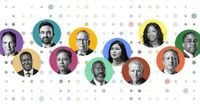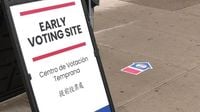As New York City’s 2025 primary election approached its climax, early voting numbers shattered previous records, signaling a surge of civic engagement across the boroughs. By the close of early voting on Sunday, June 22, over 385,000 New Yorkers had cast their ballots, more than doubling the turnout seen during the same period in the 2021 primary, according to the New York City Board of Elections.
Brooklyn led the pack with 112,458 voters, closely followed by Manhattan with 99,331, Queens with 59,701, the Bronx tallying 24,415, and Staten Island contributing 9,991 early votes. These figures reflect a city energized and divided as the primary race for mayor heats up, with candidates making their final pitches to an electorate eager for change.
On the ground, the political atmosphere was electric. Crown Heights hosted a spirited Get Out The Vote rally on Sunday night, where 33-year-old Democratic socialist Zohran Mamdani energized supporters with bold promises. Mamdani, once polling at a mere 1%, has surged to a strong contender close behind the front-runner, former Governor Andrew Cuomo.
At the rally, Mamdani laid out his vision: "This city can actually be affordable. This city deserves a mayor who will freeze the rent, make buses fast and free and make universal healthcare." His platform also includes free childcare and non-profit grocery stores. While critics question the feasibility and funding of such ambitious policies, Mamdani’s message resonates with a growing coalition of progressive voters.
Andrew Cuomo, a seasoned politician with a controversial past, remains the front-runner. The 67-year-old former governor, who resigned amid multiple sexual harassment allegations and criticism over his handling of the COVID-19 pandemic, addressed concerns about the city’s population decline. "We lost 500,000 people in New York City since COVID, 500,000 disproportionately the wealthiest, because they left because of the taxes," Cuomo said, though many note the exodus began under his watch.
Cuomo’s campaign emphasizes experience and public safety. Appearing alongside Junior Feliz Guzmanan’s mother, a victim of teen violence, Cuomo stressed the urgency of restoring safety: "One of the top priorities has to be public safety. That, in my mind, is the foundation." His call for increased policing and leadership with experience aims to appeal to voters concerned about crime and stability.
Meanwhile, the New York Working Families Party throws its weight behind progressive candidates like Mamdani and City Comptroller Brad Lander. Lander, aligning himself with Mamdani’s vision, criticized Cuomo’s legacy sharply: "We've got a City Hall so corrupt it's going to need to be cleaned out with a power washer. Working families bring a power washer. Andrew Cuomo just brings in more corruption." He also highlighted Cuomo’s abuse of power as symptomatic of deeper issues, a sentiment echoed by Lindsay Boylan, one of Cuomo’s accusers, who stood with Lander during campaign events.
The primary’s ranked-choice voting system adds a strategic layer to the contest. Voters can select up to five candidates, ranking them by preference, which allows multiple progressive candidates to share support without splitting the vote. This system has encouraged a broad field of contenders to campaign actively, knowing that second and third preferences could be decisive.
Harlem’s National Action Network hosted a gathering on Saturday morning where no fewer than four mayoral candidates posed with the Rev. Al Sharpton, signaling the importance of community and civil rights endorsements. Spike Lee, the acclaimed filmmaker, also urged voters to brave the forecasted 100-degree heat on primary day, June 24, emphasizing the importance of participation regardless of weather conditions.
Council Speaker Adrienne Adams made a poignant appearance, reflecting on the challenges faced by families in the city. "I know what it feels like to be a mother. I know what it feels like to be a mother in pain, and I know what it feels like to want more for your children than the city is offering right now," she said, tapping into the hopes and frustrations of many New Yorkers.
Queens Assemblyman and Councilman Zohran Mamdani also spent the weekend engaging directly with voters and securing endorsements from local politicians like Councilwoman Julia Wan, who praised his dedication to affordable housing and land use projects. "This is an ever-expanding movement. This is a coalition," Mamdani said, underscoring the grassroots energy propelling his campaign.
On Staten Island, early voting participation was robust, with nearly 10,000 residents casting ballots before early voting closed. Staten Islanders faced a diverse ballot, including races for mayor, public advocate, city comptroller, and local council and assembly seats, reflecting the borough’s unique political landscape. Voters registered with the Democratic and Republican parties participated in nominating their respective candidates, ahead of the general election in November.
With early voting concluded, all eyes now turn to primary day on Tuesday, June 24, 2025. The stakes are high: New York City’s next mayor will face the daunting task of addressing affordability, public safety, and post-pandemic recovery in a city that has seen dramatic demographic shifts and political upheaval.
As the city braces for what promises to be a hot and historic election day, the diverse voices and visions vying for leadership highlight the complex challenges and hopes of New Yorkers. Whether voters choose experience, progressive change, or a blend of both, the outcome will shape the city’s future for years to come.


